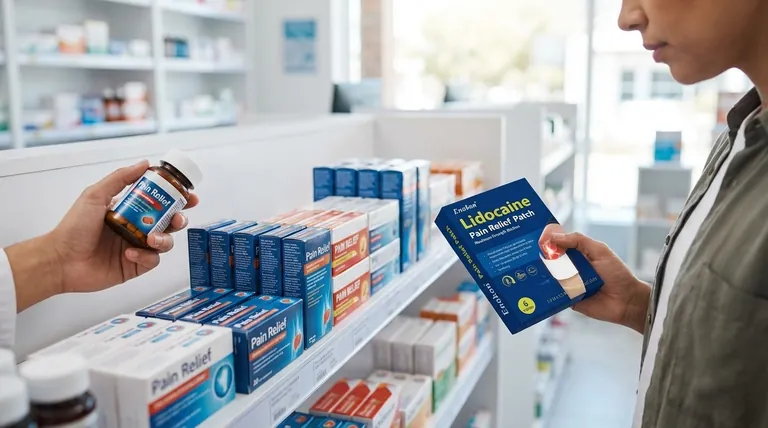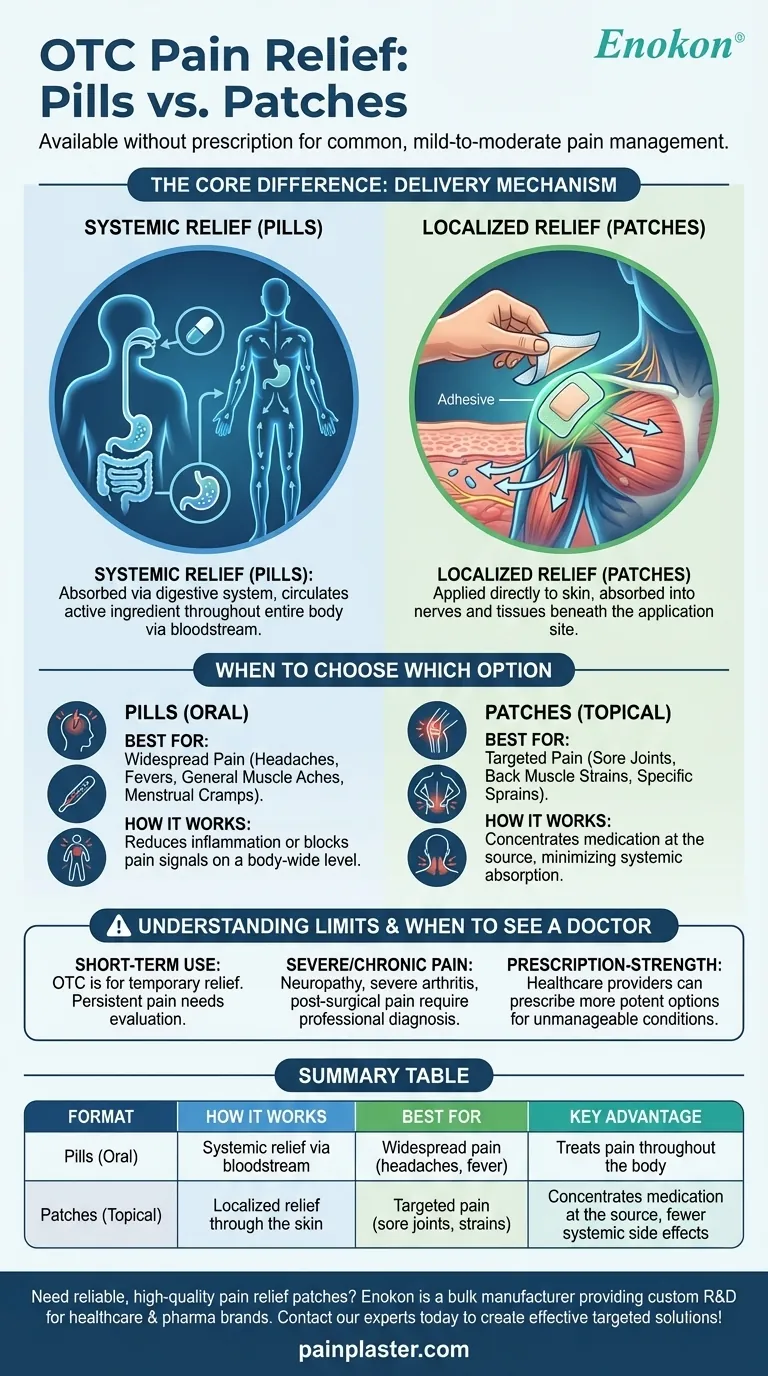Yes, absolutely. Both pain relief pills and patches are widely available over-the-counter (OTC) without a prescription. These nonprescription options are designed to manage common, mild-to-moderate pain, while more potent versions for severe or chronic conditions require a doctor's supervision.
The critical difference lies in how they work: OTC pills provide systemic relief for widespread pain, while patches offer localized relief for pain in a specific area. Understanding this distinction is the key to choosing the most effective option for your needs.

How Over-the-Counter Pain Relief Works
To make an informed choice, you must first understand the fundamental delivery mechanism of each format. One treats the whole body, while the other targets a single spot.
Systemic Relief: Oral Medications (Pills)
When you take a pill, it is absorbed through your digestive system and enters your bloodstream. This means the active ingredient circulates throughout your entire body.
This systemic approach is highly effective for pain that is widespread, internal, or doesn't have a single, specific source point. Think of headaches, fevers, menstrual cramps, or general muscle soreness after a workout.
Localized Relief: Topical Patches
A pain relief patch is applied directly to the skin over the area that hurts. The medication is then absorbed through the skin to work on the nerves and tissues directly beneath it.
This method delivers a concentrated dose of medication right where you need it most, minimizing the amount that enters your bloodstream. It is ideal for targeted pain, such as a sore shoulder, a strained lower back muscle, or an arthritic knee.
Pills vs. Patches: Aligning the Solution with the Problem
The right choice depends entirely on the nature and location of your pain. Using the wrong format can lead to less effective relief or unnecessary side effects.
When to Choose Pills
Oral medications are the standard choice for pain that isn't confined to one small area. They work by reducing inflammation or blocking pain signals on a body-wide level.
Use pills for conditions like tension headaches, fever-related body aches, and inflammatory pain that affects multiple joints.
When to Choose Patches
Patches excel when you can point to the exact spot that hurts. By concentrating the medicine at the source, they can provide powerful relief with fewer systemic side effects, such as the stomach irritation sometimes associated with oral pain relievers.
Use a patch for a pulled muscle in your neck, a sore joint, or pain from a specific strain or sprain.
Understanding the Limits and When to See a Doctor
While OTC options are convenient and effective for many common ailments, they are not a solution for every type of pain. Recognizing their limitations is crucial for your safety and well-being.
The Role of Prescription-Strength Options
For moderate to severe pain, chronic conditions, or pain stemming from nerve damage (neuropathy), nonprescription products are often insufficient.
Healthcare providers can prescribe more potent pills or patches to manage conditions like severe arthritis, post-surgical pain, or chronic cancer pain. These controlled medications require a professional diagnosis and monitoring.
Know When to Stop
Over-the-counter pain relief is intended for short-term use. If your pain persists for more than a few days, worsens, or is severe from the start, it is a signal that you need a medical evaluation.
Masking a serious underlying problem with OTC medication can delay a proper diagnosis and treatment.
Making the Right Choice for Your Pain
To select the best nonprescription option, match the product's delivery method to your specific symptom.
- If your primary focus is widespread pain (like a headache or fever): Oral pills provide effective systemic relief by circulating through your entire body.
- If your primary focus is localized pain (like a sore knee or back muscle): A patch delivers targeted medication directly to the source, minimizing effects on the rest of your body.
- If your pain is severe, chronic, or doesn't improve: Consulting a healthcare professional is the necessary next step to get a proper diagnosis and effective treatment plan.
By understanding how these products work, you can confidently select the right tool to manage your pain effectively.
Summary Table:
| Format | How It Works | Best For | Key Advantage |
|---|---|---|---|
| Pills (Oral) | Systemic relief via bloodstream | Widespread pain (headaches, fever, muscle aches) | Treats pain throughout the body |
| Patches (Topical) | Localized relief through the skin | Targeted pain (sore joints, back muscle strain) | Concentrates medication at the source, fewer systemic side effects |
Need reliable, high-quality pain relief patches? As Enokon, a bulk manufacturer of reliable transdermal patches and pain plasters, we provide healthcare and pharma distributors and brands with custom R&D and development expertise. Let us help you create an effective, targeted pain management solution for your customers. Contact our experts today to discuss your needs!
Visual Guide

Related Products
- Lidocaine Hydrogel Pain Relief Patch for Pain Relief
- Far Infrared Deep Heat Relief Patches Medicated Pain Relief Patches
- Capsaicin Chili Medicated Pain Relief Patches
- Icy Hot Menthol Medicine Pain Relief Patch
- Menthol Gel Pain Relief Patch
People Also Ask
- For what condition are lidocaine patches approved in the United Kingdom? A Guide to Postherpetic Neuralgia Treatment
- How can you use lidocaine patches for multiple sore spots? A Guide to Safe, Effective Pain Relief
- How are lidocaine patches typically used for pain relief during pregnancy? A Guide to Safe, Targeted Relief
- How does the lidocaine patch work? Targeted Relief for Nerve Pain Explained
- When should someone contact a doctor regarding lidocaine patch use? Ensure Safe Pain Relief
















